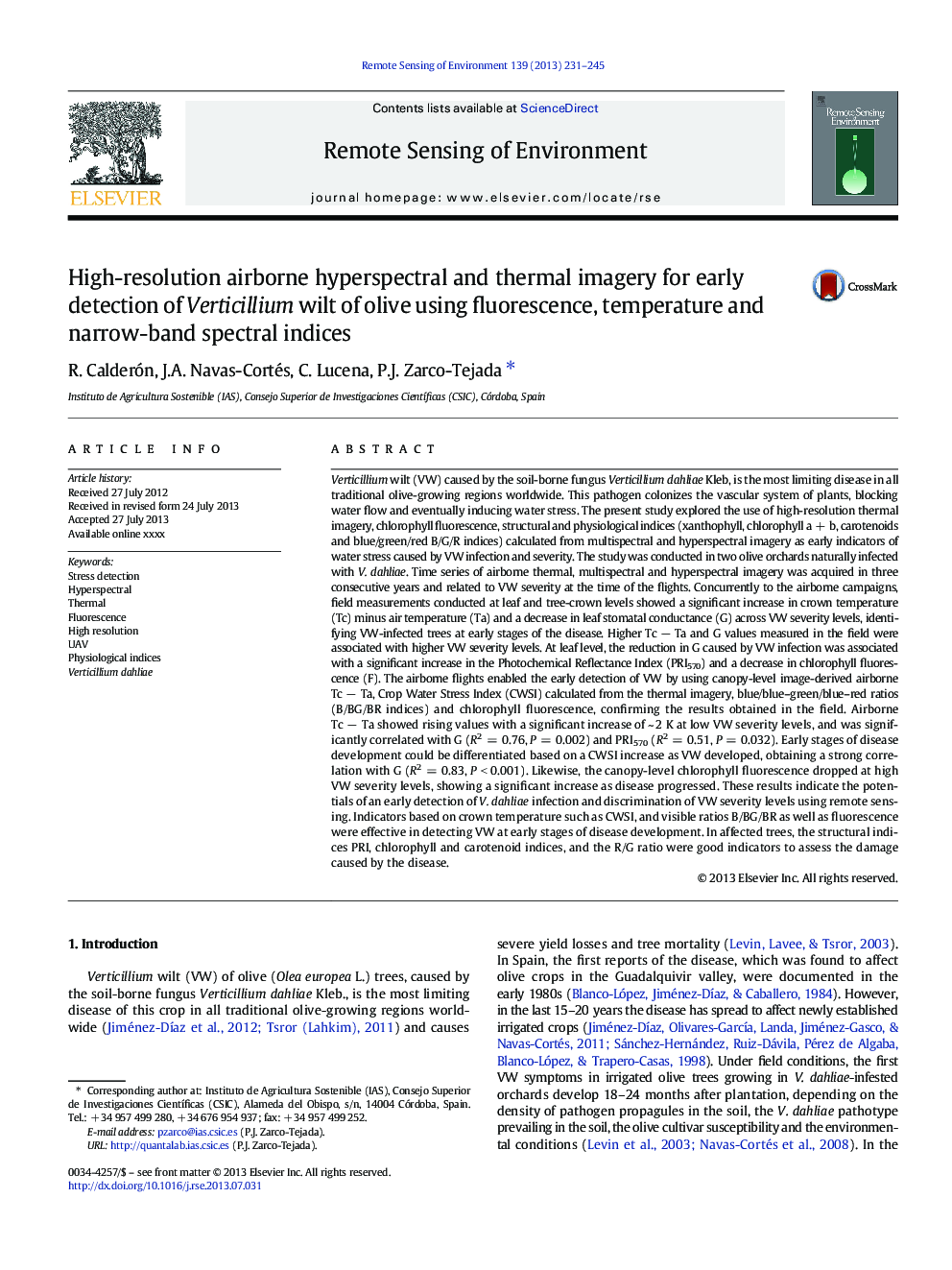| کد مقاله | کد نشریه | سال انتشار | مقاله انگلیسی | نسخه تمام متن |
|---|---|---|---|---|
| 6347140 | 1621261 | 2013 | 15 صفحه PDF | دانلود رایگان |
عنوان انگلیسی مقاله ISI
High-resolution airborne hyperspectral and thermal imagery for early detection of Verticillium wilt of olive using fluorescence, temperature and narrow-band spectral indices
ترجمه فارسی عنوان
اشعه ماوراء بنفش و تصویر حرارتی با وضوح بالا برای تشخیص زودرس ویتیلیوم ویتامین زیتون با استفاده از شاخص های طیفی فلورسانس، دما و باریک
دانلود مقاله + سفارش ترجمه
دانلود مقاله ISI انگلیسی
رایگان برای ایرانیان
کلمات کلیدی
موضوعات مرتبط
مهندسی و علوم پایه
علوم زمین و سیارات
کامپیوتر در علوم زمین
چکیده انگلیسی
Verticillium wilt (VW) caused by the soil-borne fungus Verticillium dahliae Kleb, is the most limiting disease in all traditional olive-growing regions worldwide. This pathogen colonizes the vascular system of plants, blocking water flow and eventually inducing water stress. The present study explored the use of high-resolution thermal imagery, chlorophyll fluorescence, structural and physiological indices (xanthophyll, chlorophyll a + b, carotenoids and blue/green/red B/G/R indices) calculated from multispectral and hyperspectral imagery as early indicators of water stress caused by VW infection and severity. The study was conducted in two olive orchards naturally infected with V. dahliae. Time series of airborne thermal, multispectral and hyperspectral imagery was acquired in three consecutive years and related to VW severity at the time of the flights. Concurrently to the airborne campaigns, field measurements conducted at leaf and tree-crown levels showed a significant increase in crown temperature (Tc) minus air temperature (Ta) and a decrease in leaf stomatal conductance (G) across VW severity levels, identifying VW-infected trees at early stages of the disease. Higher Tc â Ta and G values measured in the field were associated with higher VW severity levels. At leaf level, the reduction in G caused by VW infection was associated with a significant increase in the Photochemical Reflectance Index (PRI570) and a decrease in chlorophyll fluorescence (F). The airborne flights enabled the early detection of VW by using canopy-level image-derived airborne Tc â Ta, Crop Water Stress Index (CWSI) calculated from the thermal imagery, blue/blue-green/blue-red ratios (B/BG/BR indices) and chlorophyll fluorescence, confirming the results obtained in the field. Airborne Tc â Ta showed rising values with a significant increase of ~ 2 K at low VW severity levels, and was significantly correlated with G (R2 = 0.76, P = 0.002) and PRI570 (R2 = 0.51, P = 0.032). Early stages of disease development could be differentiated based on a CWSI increase as VW developed, obtaining a strong correlation with G (R2 = 0.83, P < 0.001). Likewise, the canopy-level chlorophyll fluorescence dropped at high VW severity levels, showing a significant increase as disease progressed. These results indicate the potentials of an early detection of V. dahliae infection and discrimination of VW severity levels using remote sensing. Indicators based on crown temperature such as CWSI, and visible ratios B/BG/BR as well as fluorescence were effective in detecting VW at early stages of disease development. In affected trees, the structural indices PRI, chlorophyll and carotenoid indices, and the R/G ratio were good indicators to assess the damage caused by the disease.
ناشر
Database: Elsevier - ScienceDirect (ساینس دایرکت)
Journal: Remote Sensing of Environment - Volume 139, December 2013, Pages 231-245
Journal: Remote Sensing of Environment - Volume 139, December 2013, Pages 231-245
نویسندگان
R. Calderón, J.A. Navas-Cortés, C. Lucena, P.J. Zarco-Tejada,
